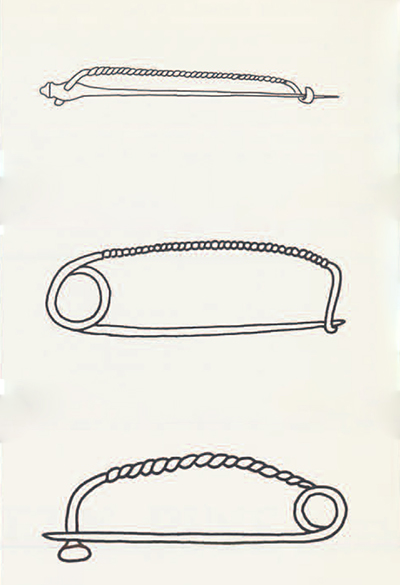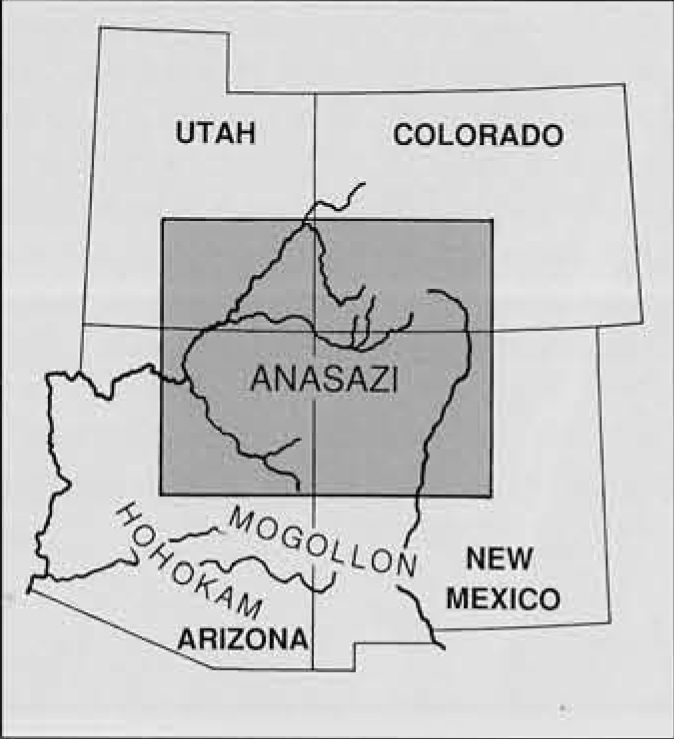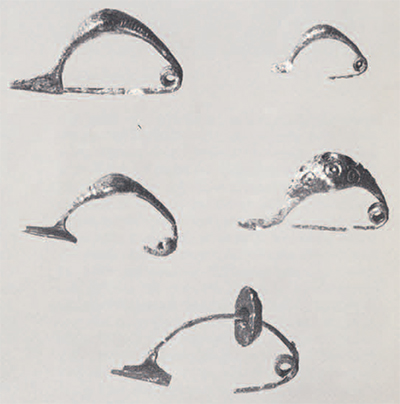One of the most interesting types of archaeological research is that concerned with tracing the history of a particular object in its development over many centuries and its adaptation in different lands. Much more interesting is this research if the object studied is one which is of general use in contemporary times.

Pottery, of course, comes immediately to mind as a product of the past which is still very much in use, but few people are aware that the common safety pin also has an ancient history, one which begins somewhere in Europe in the thirteenth century B.C. Archaeologists are indeed aware that safety pins, technically called fibulae, were first invented in Bronze Age Europe but there is some disagreement concerning the exact place where this invention occurred because it is not easy to arrive at exact dates for the cultural periods of those areas where fibulae first begin to appear, such as the Late Terramare period in northern Italy, the Bronze Age IIB period in northern Europe, and the Late Mycenaean IIIB period in Greece. These periods are all dated on the basis of Near Eastern, Anatolian, and Egyptian relationships as determined by trade objects exchanged with these areas, and, of course, on the cultural interrelationships among the European areas themselves. If the archaeologist could be certain that a group of fibulae appeared earlier in one place than in any other, he would be able to conclude, naturally, a priority of manufacture, or invention, for that area. But because the work involved in dating a given cultural horizon is complex and because archaeologists disagree among themselves about the dates to be assigned to certain periods, various centers of origin for fibulae have been suggested. Thus North Europe or the Scandinavian area, Central Europe, North Italy, and Greece have all been championed as the home of the Urfibel, or first fibula.
A further complication, other than that of simple chronology, is presented by the fact that there are two basic forms of fibulae known in Europe. One is a two-piece fibulae which consists of two originally straight pins. One of these pins forms a bow, or arc, and has a hole at one end for a small hook, the catch, formed by bending, at the other. The butt end of the second pin fits into the hole while its tip rests on the catch. There is no sprig and both pins are mobile. The second fibula–like the modern safety pin–consists of one originally straight pin bent into a loop at the middle to form a spring. One end is the pin while the other is bent into a hook to hold it, tension being provided by the spring. It is interesting to note that one-piece fibulae are found in central Europe, Italy, and Greece, but that they are not found in northern Europe. On the other hand, two-piece fibulae are commonly found in the north but only a very few have been found in central Europe and Italy, and these are clearly imports from the north. Some scholars, such as Sundwall in his Die Alteren Italischen Fibeln and Kossinnas in his Die Deutsche Vorgeschichte, have argued that the northern two-piece type is stylistically and chronologically earlier than the one-piece. The invention of the fibula is, therefore, attributed to the north by these authors who suggest that the idea subsequently diffused to the south and southeast where a one-piece fibula was preferred. Recent evaluation of European chronology, however, seems to suggest that the appearance of the two-piece fibula in the north occurs later than does the one-piece form in the south; so the theory of northern priority cannot be maintained. Furthermore, as several scholars have noted, there is no necessary direct relationship between the two forms of fibula under discussion.


When we examine the evidence for the chronological appearance of the one-piece fibula, we note that it appears in the Late Terramare period in Italy, and in the Mycenaean IIIB period in Greece. The latter is usually dated to the thirteenth century B.C. Since no Mycenaean pottery (one of the best objects used for dating the Late Bronze Age) has yet been found in Italy north of the Naples area, we cannot be certain about the dates to be assigned to North Italian cultures; but some scholars, such as C.F.C. Hawkes, date the Italian culture in which early fibulae first appear to a time after the Mycenaean IIIB period. Hawkes, and before him, Blinkenberg in his important book, Fibules Grecques et Orientales, in fact, derive all fibulae from Mycenaean Greece. One thing is clear–the earliest fibulae in Italy and Greece are exactly the same types and could only have been the product of one center; independent invention played no role here. Since there is no place in Europe that can claim to have produced fibulae before those known in Greece, we must, at least for the present, accept a Mycenaean Greek origin for the fibula. At the same time, however, one must consider a separate development in northern Europe (the two-piece form) which may be a result either of independent invention or a stimulus from the south.
The theory of a Mycenaean origin is indeed not without problems. Fibulae appear a short time, it would seem, before the destruction of the Mycenaean civilization by the Dorians, which occurred in the twelfth century B.C. Only after the destruction in sub-Mycenaean and subsequent periods, did the use of the fibula become popular. Its extensive use suggests a new type of clothing, pinned rather than seamed. Did this new style signify the arrival of a people in Greece prior to the Dorians? If the answer is yes (it need not be), then we are back where we started: where did the new people–and their fibulae–come from? But these problems notwithstanding, until earlier fibulae are forthcoming in an area other than Greece, it seems best to accept a Greek priority. We need not, however, consider the matter closed.

The archaeologist’s interest in fibulae is not limited to the problem of their place of origin within Europe. He is also concerned with their geographical distribution, their cultural and chronological development, and, moreover, he is interested in knowing how the ancients used fibulae and what significance was attached to them. Let us discuss further the question of how the fibula was used by the ancients and what its value is to the archaeologist historian.
Primarily, the fibula was employed to fasten together two edges of a garment (like the modern button), or to fasten an upper to an undergarment. A straight pin was less secure and more dangerous, for the point remained exposed–hence the invention of the “safety pin.” In some areas, however, we find that the straight pins and fibulae were used on clothing simultaneously. Since fibulae had to be worn, and were visible to the public, within a short time they became decorative so that they began to function also as jewelry. Hence the originally humble fibula was manufactured in various materials such as gold, silver, electrum bone, and ivory, as well as the more common bronze. A countless variety of shapes, types, and sizes were created, for both men and women. Fibulae from every area of the ancient world where they were employed, especially Italy and Europe, exhibit an amazing number of types which are both utilitarian and decorative. Indeed, some fibulae may have been valued primarily as jewelry. This is the impression one gets after examining, for example, such elaborate specimens as Etruscan gold fibulae or bronze fibulae from Boeotia in Greece.

A further decorative use of fibulae is to be seen on some of the belt buckles found at Ankara, Gordion, Ephesus, and Chios. Here fibulae arcs of different types served as clasps for the belt and demonstrate that the fibula shape itself was considered aesthetic enough to function other than as a safety pin.
A more fascinating use of fibulae may be observed, particularly in the Greek regions where archaeologists have recognized for some time that at many (but possibly not all) sanctuaries, fibulae played a major role as votive gifts to gods and goddesses This votive role is shown both by the large number of fibulae found at sanctuaries and by ancient literary and epigraphical records. For example, at a sanctuary on the island of Rhodes about sixteen hundred fibulae were found in votive deposits, and at least one sanctuary deposit, that at Ephesus, contained pieces of thin gold and silver foil cut into the form of fibulae. These simulacra could not possibly have been worn and were made only for the purpose of dedication. Furthermore, at Nimrud in Assyria, a limestone plaque was found on which was depicted a female demon or deity surrounded by objects, one of which appears to be a fibula. If these objects were votive gifts to the deity, as some scholars suggest, then we can assume that Assyrians as well as Greeks recognized fibulae as having some votive value.

It is tempting to consider the possibility that if fibulae had some special value in sanctuaries, they may also have had some special value in a tomb where the dead person would soon come into contact with his gods. We know that the dead as well as the living wore fibulae. In fact, there is evidence that some dead persons wore a greater quantity of fibulae than was normal in daily dress. This difference becomes obvious when one examines the number of fibulae worn by people represented on sculpture, reliefs, or painted vases, and compares them to the number of fibulae often found associated with burials. In the former circumstances only a few fibulae, sometimes only one, are evident, whereas in the burials many more are often found. Thus the man buried under the big tumulus at Gordion was laid to rest with thirty-seven fibulae about his body and a bad containing 145 fibulae was placed near his bier. A child of three or four years found in an early Roman cemetery had nine fibulae placed on her body. There are many other examples to indicate that more fibulae were thought necessary to decorate a dead person than were worn during his lifetime. Evidently one had to be excessively well dressed for the entry into the other world.
These various discoveries and their interpretations give us knowledge and insights about the use of a small object, the fibula, in antiquity. But fibulae, like pottery, tell the archaeologist more than just how they were used by the ancients. In fact, the scholar Kossinnas called fibulae “the most important of all ornaments” for archaeological study. A fibula, like a potsherd, can indicate to an archaeologist its date and area of manufacture almost as well as if there had been an identifying label attached. This information is important in supplying a date for the particular level or tomb where the fibula is found. It may also yield valuable information about the cultural relations of a people whose local fibulae are found in a foreign land as a trade item. Fibulae can be used for dating and tracing trade connections because, once different peoples learned about them, they developed them stylistically to suit their own cultural and aesthetic needs. Thus the extraordinarily elaborate development of fibulae in Italy was quite different from that in Greece, the country from which we have suggested the Italians originally received the fibula. And when the use of the fibula spread east from Greece through the islands to Cyprus and the Near East, an entirely different series of fibula types came into existence. Likewise when the Phrygians learned about fibulae from the Aegean area and from Cyprus and introduced them into Anatolia in the latter part of the eighth century B.C., they too produced their own very distinctive types. Hence no archaeologist would recognize the fibulae from the University Museum’s excavations at Gordion and Nippur as anything but Phrygian and Near Eastern, respectively. Those from the 1890 expedition to Nippur have only recently been cleaned by Eric Parkinson, and are illustrated here for the first time. Sometimes there is an “overlap” between two areas. For example, leech-shaped fibulae like those shown here from a tomb at Narce, Italy, are found in both Italy and Greece and archaeologists argue about their original home; fortunately this problem is not too common.

We have already observed the role played by fibulae in regard to possible movements of people into Greece. Two other examples of the role of fibulae come from University Museum expeditions, and further illustrate their importance.
At Hasanlu, Iran, in 1962 a bronze fibula was found, the only one known at present from the site, in a level of Hasanlu III, the Triangle Ware Period. Since the city represented by Period III had been abandoned and much eroded, very little was found besides some pottery, which could not be easily dated. All that was known of Period III was that it came into existence after the destruction of the Period IV city which occurred in the ninth century B.C. A welcome Carbon-14 date suggested a seventh-sixth century date for the life of the Period III city. The fibula found, however, was of a type known from the ruins of the ancient Urartean fortress of Karmir Blur (in modern Armenia), which was destroyed about 600 B.C. This fibula type has one end of the pin wrapped around the arc end opposite the catch and it does not form a spring. In the University Museum collection there is a similar type of fibula (but with a different arc shape) purchased in Armenia at the turn of the century and illustrated now for the first time. The excavators of Hasanlu have gleaned, then, from this one fibula a chronological indication supporting a Carbon-14 reading, as well as a suggestion of possible cultural or commercial contacts with an ancient Urartean city.
Excavation at the site of Gordion further documents the archaeological importance of fibulae. The ruins of Gordion are producing much information about the Phrygians, their material culture, and their cultural connections with other lands. Of particular interest is the nature and extent of their relationship with people of the Mediterranean areas. According to the Greek historian Herodotus, the Phrygians and Mainland Greeks were in contact with each other in the late eighth century B.C. at which time King Midas sent a throne to Delphi as a gift. We now know that Phrygian objects of the eighth century B.C. are found in other Greek sanctuaries besides Delphi: Olympia, Perachora, the Argive Heraeum, Aetos on Ithaca, Aphaia on Aegina, Artemis Orthia at Tegea. In the last three mentioned sanctuaries, significantly, these objects are represented only by Phrygian fibulae. Thus the fibulae play a major role in documenting a more extensive contact between Greece and Phrygia than that suggested by Herodotus.



Museum Object Number(s): 30-33-31
Finally a single Phrygian fibula of the late eighth or early seventh century B.C. was found in Italy near Rome. It is, to my knowledge, the only bona fide Phrygian object (except perhaps for a bull’s head protome found at Cumae) found in Italy up to the present time, and as such is of great value. We must, however, temper our enthusiasm with caution. The fact that Phrygian objects are found in Greece and Italy tells us nothing about the manner in which they arrived. Did Phrygians bring them to Italy and Greece, did Greeks and Italians bring them back from a journey to Phrygia, or did a third party act as a middleman for both Greece and Italy? Herodotus tells us about Phrygians going to Greece; so it would not be wrong to see the fibulae as evidence that itinerant Phrygians left their fibulae as offerings at Greek temples, perhaps as a token of pious courtesy to the foreign gods. Further research may some day clarify the true nature of the contact between Italy and Phrygia suggested by the fibula.
Thus the familiar safety pin, an unpretentious article of daily use in the modern world, takes on a new significance when viewed through the eyes of the archaeologist, and has its rightful place in the Museum’s collection.

